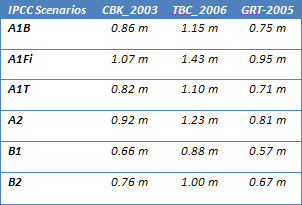Using an inverse statistical model we examine potential response in sea level to the changes in natural and anthropogenic forcings by 2100. With six IPCC radiative forcing scenarios we estimate sea level rise of 0.6-1.6 m, with confidence limits of 0.59 m and 1.8 m. Projected impacts of solar and volcanic radiative forcings account only for, at maximum, 5% of total sea level rise, with anthropogenic greenhouse gasses being the dominant forcing.
As alternatives to the IPCC projections, even the most intense century of volcanic forcing from the past 1000 years would result in 10-15 cm potential reduction of sea level rise. Stratospheric injections of SO2 equivalent to a Pinatubo eruption every 4 years would effectively just delay sea level rise by 12 -20 years. A 21st century with the lowest level of solar irradiance over the last 9300 years results in negligible difference to sea level rise.
Citation: Jevrejeva, S., J. C. Moore, and A. Grinsted (2010), Hown will sea level respond to changes in natural and anthropogenic forcingsn by 2100? Geophys. Res. Lett., doi:10.1029/2010GL042947 PDF
Agreement on future sea level rise.
Sea level will rise by roughly 1 m by the year 2100. This result agrees well with previous estimates projections by Grinsted et al. 2009, Vermeer & Rahmstorf, 2009, and Rahmstorf 2007, while using a completely independent forcing. It also agrees qualitatively with other evidence from Rohling et al. 2007, Carlson et al. 2008, and Pfeffer et al. 2008.
Although it is too early to say that a consensus has been reached in the sea level community, it is clear that the bulk of the recent studies show a much greater sea level rise than projected in IPCC AR4.

Table showing our best guess projections sea level rise for 2100 ADn(relative to 1980-2000). The different columns refer to differentestimates of the historical radiative forcing.
Long-term sea level response to global warming
Sea level has a long response time and so the warming we impose now will have consequences far into the future. This is an issue of commitment and is discussed in the IPCC AR4 report. It is not discussed in this paper, but here is a crude estimate of the long term sea level response.
Our press release from this study got a mention on the Colbert Report.
